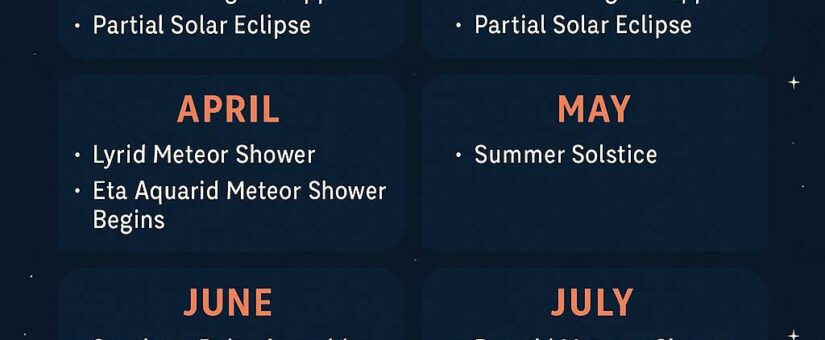
Major Celestial Events of 2025
- Posted by OCastronomy
- On January 1, 2025
- 0 Comments
- Eta Aquarid meteor shower, Geminid Meteor Shower, Lyrid meteor shower, Major Celestial Events of 2025, meteor shower, Orionid meteor shower, Supermoon, Total Lunar Eclipse
Major celestial events of 2025
Astronomy enthusiasts, prepare for an exciting year ahead.
This month-by-month guide highlights the major celestial events of 2025, with a focus on optimal viewing conditions for observers in Southern California. From solar and lunar eclipses to meteor showers, planetary conjunctions, and supermoons, 2025 presents a dynamic range of astronomical phenomena. Whether tracking planetary alignments or capturing deep-sky events through a telescope, this year offers exceptional opportunities to explore and appreciate the evolving cosmos.
🌟 January 2025
- Quadrantid Meteor Shower (Jan 2–3): This meteor shower peaks with up to 120 meteors per hour. Best viewed after midnight under dark skies. (April Will Have 2 Meteor Showers Happening Simultaneously – How to Watch the Rare Spectacle)
- Planetary Parade (Jan 1–4): A rare alignment where all seven planets are visible in the sky simultaneously. (Texas skies to dazzle in January with rare planetary alignment beginning Friday)
- Mars Occultation by the Moon (Jan 13): The Moon passes directly in front of Mars, temporarily obscuring it from view.
- Venus–Saturn Conjunction (Jan 17–18): Venus and Saturn appear very close together in the evening sky. (Meteor showers, northern lights and supermoons:)
🌕 February 2025
- Planetary Parade Continues (Feb 28): All seven other planets in the solar system appear aligned in the sky. (From Saturn’s once-in-a-decade disappearing rings to intense Northern Lights – five must-see space spectacles for 2025)
🌑 March 2025
- Total Lunar Eclipse (Mar 14): The Moon passes through Earth’s shadow, turning a deep red color.
- Saturn’s Rings Disappear (Mar): Saturn’s rings appear edge-on from Earth, making them nearly invisible. (From Saturn’s once-in-a-decade disappearing rings to intense Northern Lights – five must-see space spectacles for 2025)
- Partial Solar Eclipse (Mar 29): The Moon partially covers the Sun, creating a noticeable dimming.
🌠 April 2025
- Lyrid Meteor Shower (Apr 21–22): An annual meteor shower producing up to 20 meteors per hour. (April Will Have 2 Meteor Showers Happening Simultaneously – How to Watch the Rare Spectacle)
- Eta Aquarid Meteor Shower Begins (Apr 20): This meteor shower, originating from Halley’s Comet, becomes active, peaking in early May. (April Will Have 2 Meteor Showers Happening Simultaneously – How to Watch the Rare Spectacle)
🌌 May 2025
- Eta Aquarid Meteor Shower Peak (May 3–4): A meteor shower with up to 50 meteors per hour, best viewed in the pre-dawn hours. (April Will Have 2 Meteor Showers Happening Simultaneously – How to Watch the Rare Spectacle)
🌟 June 2025
- Summer Solstice (Jun 21): The longest day of the year in the Northern Hemisphere.
🌠 July 2025
- Southern Delta Aquarid Meteor Shower (Jul 29–30): A meteor shower producing up to 25 meteors per hour. (April Will Have 2 Meteor Showers Happening Simultaneously – How to Watch the Rare Spectacle)
- Alpha Capricornid Meteor Shower (Jul 29–30): A meteor shower known for bright fireballs. (Starwatch: Lyrid meteor showers to grace skies with annual stellar show)
🌠 August 2025
- Perseid Meteor Shower (Aug 12–13): One of the most popular meteor showers, producing up to 100 meteors per hour. (April Will Have 2 Meteor Showers Happening Simultaneously – How to Watch the Rare Spectacle)
🌕 September 2025
- Total Lunar Eclipse (Sep 7): Another opportunity to witness the Moon turning red as it passes through Earth’s shadow.
🌕 October 2025
- Supermoon (Oct 6): The Moon appears larger and brighter as it reaches its closest point to Earth.
- Orionid Meteor Shower (Oct 22–23): A meteor shower producing up to 20 meteors per hour.
🌕 November 2025
- Supermoon (Nov 5): Another close approach of the Moon, making it appear larger and brighter.
- Leonid Meteor Shower (Nov 16–17): A meteor shower known for producing bright meteors.
🌕 December 2025
- Supermoon (Dec 4): The third and final supermoon of the year. (From eclipses to supermoons, here are some of the space events happening in 2025)
- Geminid Meteor Shower (Dec 13–14): One of the best meteor showers, producing up to 120 meteors per hour.
- Ursid Meteor Shower (Dec 21–22): A meteor shower producing up to 10 meteors per hour. (Meteor Shower calendar 2025: Key dates and moonlight viewing conditions)
Be sure to visit This Month’s Sky to find the best times, locations, and conditions for events throughout the year.

